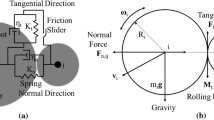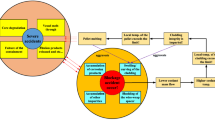Abstract
Various sources of solid particles might exist in the coolant flow of a liquid metal cooled fast reactor (e.g., through chemical interaction between the coolant and impurities, air, or water, through corrosion of structural materials, or from damaged/molten fuel). Such particles may cause flow blockage accidents in a fuel assembly, resulting in a reduction in coolant flow, which potentially causes a local temperature rise in the fuel cladding, cladding failure, and fuel melt. To understand the blockage formation mechanism, in this study, a series of simulated experiments was conducted by releasing different solid particles from a release device into a reducer pipe using gravity. Through detailed analyses, the influence of various experimental parameters (e.g., particle diameter, capacity, shape, and static friction coefficient, and the diameter and height of the particle release nozzle) on the blockage characteristics (i.e., blockage probability and position) was examined. Under the current range of experimental conditions, the blockage was significantly influenced by the aforementioned parameters. The ratio between the particle diameter and outlet size of the reducer pipe might be one of the determining factors governing the occurrence of blockage. Specifically, increasing the ratio enhanced blockage (i.e., larger probability and higher position within the reducer pipe). Increasing the particle size, particle capacity, particle static friction coefficient, and particle release nozzle diameter led to a rise in the blockage probability; however, increasing the particle release nozzle height had a downward influence on the blockage probability. Finally, blockage was more likely to occur in non-spherical particles case than that of spherical particles. This study provides a large experimental database to promote an understanding of the flow blockage mechanism and improve the validation process of fast reactor safety analysis codes.






Similar content being viewed by others
Data availability
The data that support the findings of this study are openly available in Science Data Bank at https://www.doi.org/10.57760/sciencedb.j00186.00033 and https://cstr.cn/31253.11.sciencedb.j00186.00033.
References
Y. Gao, Y. Zhu, Analysis of the influence on environmental radiation level of Qinshan area caused by Fukushima nuclear accident. Nucl. Sci. Tech. 25, S010606 (2014). https://doi.org/10.13538/j.1001-8042/nst.25.S010606
T. Zhang, S. Cheng, T. Zhu et al., A new experimental investigation on local fuel-coolant interaction in a molten pool. Ann. Nucl. Energy 120, 593–603 (2018). https://doi.org/10.1016/j.anucene.2018.06.031
S. Cheng, H. Yamano, Y. Suzuki et al., Characteristics of self-leveling behavior of debris beds in aseries of experiments. Nucl. Eng. Technol. 45(3), 323–334 (2013). https://doi.org/10.5516/NET.02.2012.068
G. Yang, H. Liao, T. Ding et al., Development and validation of a new oxide fuel rod performance analysis code for the liquid metal fast reactor. Nucl. Sci. Tech. 33(5), 66 (2022). https://doi.org/10.1007/s41365-022-01045-7
X. Luo, C. Wang, Z. Zou et al., Development and application of a multi-physics and multi-scale coupling program for lead-cooled fast reactor. Nucl. Sci. Tech. 33, 18 (2022). https://doi.org/10.1007/s41365-022-01008-y
W.S. Duan, Z. Zou, X. Luo et al., Startup scheme optimization and flow instability of natural circulation lead-cooled fast reactor SNCLFR-100. Nucl. Sci. Tech. 32, 133 (2021). https://doi.org/10.1007/s41365-021-00970-3
X. Luo, L. Cao, W. Feng et al., Development of a subchannel code for blockage accidents of LMFRs based on the 3D fuel rod model. Nucl. Sci. Tech. 33(2), 27 (2022). https://doi.org/10.1007/s41365-022-01010-4
K. Shi, S. Li, X. Zhang et al., Partial flow blockage analysis of the hottest fuel assembly in SNCLFR-100 reactor core. Nucl. Sci. Tech. 29, 16 (2018). https://doi.org/10.1007/s41365-017-0351-3
J.T. Han (ed.), Blockages in LMFBR Fuel Assemblies: A Review of Experimental and Theoretical Studies (ERDA, USA, 1977). https://doi.org/10.2172/7301883
K.V. Tichelen, Blockages in LMFR Fuel Assemblies (SCK CEN, Belgium, 2012)
K. Natesan, K. Velusamy, P. Selvaraj et al., Thermal hydraulic study on detection of random failure of fuel by delayed neutron detection system. Nucl. Eng. Des. 237(23), 2219–2231 (2007). https://doi.org/10.1016/j.nucengdes.2007.03.045
M. Adorni, A. Bousbia-Salah, T. Hamidouche et al., Analysis of partial and total flow blockage of a single fuel assembly of an MTR research reactor core. Ann. Nucl. Energy. 32(15), 1679–1692 (2005). https://doi.org/10.1016/j.anucene.2005.06.001
I. Di Piazza, M. Fabrizio, T. Mariano et al., A CFD analysis of flow blockage phenomena in ALFRED LFR demo fuel assembly. Nucl. Eng. Des. 276, 202–215 (2014). https://doi.org/10.1016/j.nucengdes.2014.05.033
M. Sarkar, K. Velusamy, P. Munshi et al., Investigation of heat transfer from a totally blocked fuel subassembly of fast breeder reactor with 7 and 19 pin bundles. Nucl. Eng. Des. 338, 74–91 (2018). https://doi.org/10.1016/j.nucengdes.2018.08.001
I. Di Piazza, R. Marinari, N. Forgione, et al., CFD analyses of the internal blockage in the NACIE-UP fuel pin bundle simulator, in Paper Presented at the 17th International Topical Meeting on Nuclear Reactor Thermal Hydraulics NURETH-17, Xi'an Jiaotong University, Xi'an, 3–8 September 2017
R. Marinari, I. Di Piazza, N. Forgione et al., Pre-test CFD simulations of the NACIE-UP BFPS test section. Ann. Nucl. Energy. 110, 1060–1072 (2017). https://doi.org/10.1016/j.anucene.2017.08.046
J. Pacio, M. Daubner, F. Fellmoser et al., Heat transfer experiment in a partially (internally) blocked 19-rod bundle with wire spacers cooled by LBE. Nucl. Eng. Des. 330, 225–240 (2018)
R. Marinari, I. Di Piazza, M. Tarantino et al., Blockage fuel pin simulator experiments and simulation. Nucl. Eng. Des. 353, 110215 (2019). https://doi.org/10.1016/j.nucengdes.2019.110215
T. Kiwing, Y.L. Pik, H.K. Pak, Jamming of granular flow in a two-dimensional hopper. Phys. Rev. Lett. 86(1), 71–74 (2001)
I. Zuriguel, A. Garcimartin, D. Maza et al., Jamming during the discharge of granular matter from a silo. Phys. Rev. E 71, 051303 (2005). https://doi.org/10.1103/PhysRevE.71.051303
I. Zuriguel, L. Pugnaloni, A. Luis et al., Jamming during the discharge of grains from a silo described as a percolating transition. Phys. Rev. E. 68, 030301 (2003). https://doi.org/10.1103/PhysRevE.68.030301
J. Sienicki, in Lead-Cooled Fast Reactors. ed. by A. Waltar, D. Todd, P.V. Tsvetkov (Springer, Boston, 2012). https://doi.org/10.1007/978-1-4419-9572-8_18
F.S. Craig, G.H. William, W.B. Neil et al., SSTAR: the US lead-cooled fast reactor (LFR). J. Nucl. Mater. 376, 255–259 (2008). https://doi.org/10.1016/j.jnucmat.2008.02.049
F. Roelofs (ed.), Thermal Hydraulics Aspects of Liquid Metal Cooled Nuclear Reactors (Woodhead Publishing, London, 2018), pp.17–47. https://doi.org/10.1016/B978-0-08-101980-1.00003-X
S. Cheng, P. Gong, S. Wang et al., Investigation of flow regime in debris bed formation behavior with nonspherical particles. Nucl. Eng. Technol. 50, 43–53 (2018). https://doi.org/10.1016/j.net.2017.09.003
P.C. Arnold, A.G. McLean, An analytical solution for the stress function at the wall of a converging channel. Powder Technol. 13(2), 255–260 (1976). https://doi.org/10.1016/0032-5910(76)85011-5
A. Drescher, A.J. Waters, C.A. Rhoades, Arching in hoppers: ii. Arching theories and critical outlet size. Powder Technol. 84(2), 177–183 (1995). https://doi.org/10.1016/0032-5910(95)029828
W. Jenike, Steady gravity flow of frictional-cohesive solids in converging channels. J. Appl. Mech. 31(1), 5–11 (1964). https://doi.org/10.1115/1.3629571
D.M. Walker, An approximate theory for pressures and arching in hoppers. Chem. Eng. Sci. 21(11), 975–997 (1966). https://doi.org/10.1016/0009-2509(66)85095-9
R.A. Meyers (ed.), Statistical Mechanics of Clogging (Springer, Berlin, 2020). https://doi.org/10.1007/978-3-642-27737-5_746-1
A. Janda, I. Zuriguel, A. Garcimartin et al., Jamming and critical outlet size in the discharge of a two-dimensional silo. Europhys. Lett. 84(4), 44002 (2008). https://doi.org/10.1209/02955075/84/44002
L. Pournin, M. Ramaioli, P. Folly et al., About the influence of friction and poly-dispersi-tyon the jamming behavior of bead assemblies. Eur. Phys. J. E. 23(2), 229–235 (2007). https://doi.org/10.1140/epje/i2007-10176-5
L.A. Pugnaloni, M.G. Valluzzi, L.G. Valluzzi, Arching in tapped deposits of hard disks. Phys. Rev. E. 73, 051302 (2006). https://doi.org/10.1103/physreve.73.051302
G.A. Kohring, S. Melin, H. Puhl et al., Computer simulations of critical, non-stationary granular flow through a hopper. Comput. Methods Appl. Mech. Eng. 124(3), 273–281 (1995). https://doi.org/10.1016/0045-7825(94)00743-7
M. Hou, W. Chen, T. Zhang et al., Global nature of dilute-to-dense transition of granular flows in a 2d channel. Phys. Rev. Lett. 91(20), 204301 (2003). https://doi.org/10.1103/PhysRevLett.91.204301
S. Cheng, H. Tagami, H. Yamano et al., An investigation on debris bed self-leveling behavior with non-spherical particles. J. Nucl. Sci. Technol. 51, 1096–1106 (2014). https://doi.org/10.1080/00223131.2014.910478
Author information
Authors and Affiliations
Contributions
All authors contributed to the study conception and design. Material preparation, data collection and analysis were performed by Wen-Hui Jin, Song-Bai Cheng and Xiao-Xing Liu. The first draft of the manuscript was written by Wen-Hui Jin and all authors commented on previous versions of the manuscript. All authors read and approved the final manuscript.
Corresponding author
Ethics declarations
Conflict of interest
The authors declare that they have no competing interests.
Additional information
This work was supported by the Basic and Applied Basic Research Foundation of Guangdong Province (Nos. 2021A1515010343 and 2022A1515011582) and the Science and Technology Program of Guangdong Province (Nos. 2021A0505030026 and 2022A0505050029).
Rights and permissions
Springer Nature or its licensor (e.g. a society or other partner) holds exclusive rights to this article under a publishing agreement with the author(s) or other rightsholder(s); author self-archiving of the accepted manuscript version of this article is solely governed by the terms of such publishing agreement and applicable law.
About this article
Cite this article
Jin, WH., Cheng, SB. & Liu, XX. Experimental study on the mechanism of flow blockage formation in fast reactor. NUCL SCI TECH 34, 84 (2023). https://doi.org/10.1007/s41365-023-01246-8
Received:
Revised:
Accepted:
Published:
DOI: https://doi.org/10.1007/s41365-023-01246-8




